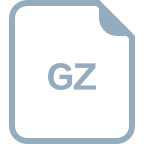
In-Datacenter Performance Analysis of a Tensor Processing Unit ISCA ’17, June 24-28, 2017, Toronto, ON, Canada
the upper-right corner, the Matrix Multiply Unit is the heart of the
TPU. It contains 256x256 MACs that can perform 8-bit multiply-
and-adds on signed or unsigned integers. The 16-bit products are
collected in the 4 MiB of 32-bit Accumulators below the matrix
unit. The 4 MiB holds 4096, 256-element, 32-bit accumulators.
The matrix unit produces one 256-element partial sum per clock
cycle. We picked 4096 by first noting that the operations per byte
needed to reach peak performance (roofline knee in Section 4) is
~1350, so we rounded that up to 2048 and then duplicated it so
that the compiler could use double buffering while running at
peak performance.
When using a mix of 8-bit weights and 16-bit activations (or
vice versa), the Matrix Unit computes at half-speed, and it
computes at a quarter-speed when both are 16 bits. It reads and
writes 256 values per clock cycle and can perform either a matrix
multiply or a convolution. The matrix unit holds one 64 KiB tile
of weights plus one for double buffering (to hide the 256 cycles it
takes to shift a tile in). This unit is designed for dense matrices.
Sparse architectural support was omitted for time-to-deployment
reasons. The weights for the matrix unit are staged through an on-
chip Weight FIFO that reads from an off-chip 8 GiB DRAM
called Weight Memory (for inference, weights are read-only; 8
GiB supports many simultaneously active models). The weight
FIFO is four tiles deep. The intermediate results are held in the 24
MiB on-chip Unified Buffer, which can serve as inputs to the
Matrix Unit. A programmable DMA controller transfers data to or
from CPU Host memory and the Unified Buffer.
Figure 2 shows the floor plan of the TPU die. The 24 MiB
Unified Buffer is almost a third of the die and the Matrix Multiply
Unit is a quarter, so the datapath is nearly two-thirds of the die.
The 24 MiB size was picked in part to match the pitch of the
Matrix Unit on the die and, given the short development schedule,
in part to simplify the compiler (see Section 7). Control is just 2%.
Figure 3 shows the TPU on its printed circuit card, which inserts
into existing servers like an SATA disk.
As instructions are sent over the relatively slow PCIe bus,
TPU instructions follow the CISC tradition, including a repeat
field. The average clock cycles per instruction (CPI) of these
CISC instructions is typically 10 to 20. It has about a dozen
instructions overall, but these five are the key ones:
1. Read_Host_Memory reads data from the CPU host
memory into the Unified Buffer (UB).
2. Read_Weights reads weights from Weight Memory
into the Weight FIFO as input to the Matrix Unit.
3. MatrixMultiply/Convolve causes the Matrix
Unit to perform a matrix multiply or a convolution from the
Unified Buffer into the Accumulators. A matrix operation
takes a variable-sized B*256 input, multiplies it by
a
256x256 constant weight input, and produces a B*256
output, taking B pipelined cycles to complete.
4. Activate
performs the nonlinear function of the
artificial neuron, with options for ReLU, Sigmoid, and so on.
Its inputs are the Accumulators, and its output is the Unified
Buffer. It can also perform the pooling operations needed for
convolutions using the dedicated hardware on the die, as it i
s
connected to nonlinear function logic.
5. Write_Host_Memory writes data from the Unified
Buffer into the CPU host memory.
The other instructions are alternate host memory read/write, set
configuration, two versions of synchronization, interrupt host,
Figure 1. TPU Block Diagram. The main computation is the
yellow Matrix Multiply unit. Its inputs are the blue Weight
FIFO and the blue Unified Buffer and its output is the blue
Accumulators. The yellow Activation Unit performs the
nonlinear functions on the Accumulators, which go to the
Unified Buffer.
Figure 2. Floorplan of TPU die. The shading follows Figure 1.
The light (blue) datapath is 67%, the medium (green) I/O is
10%, and the dark (red) control is just 2% of the die. Control
is much larger (and much harder to design) in a CPU or GPU.
Figure 3. TPU Printed Circuit Board. It can be inserted into
the slot for a SATA disk in a server.
3


















